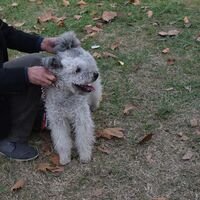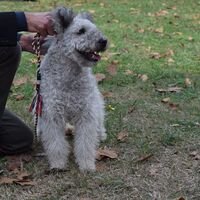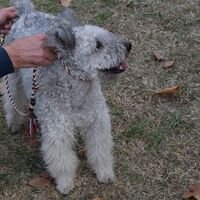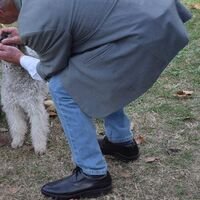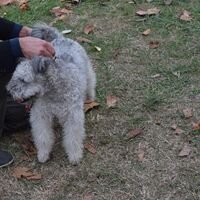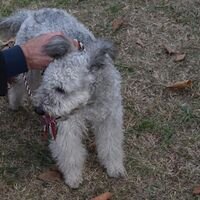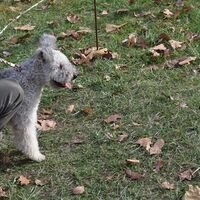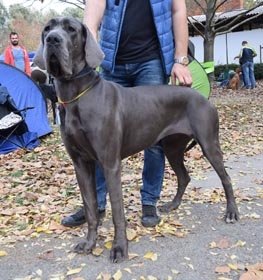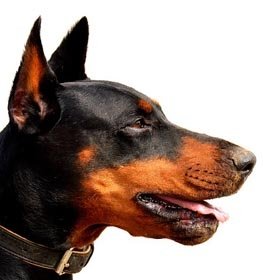Pumi Information & Dog Breed Facts
Collection of all the general dog breed info about Pumi so you can get to know the breed more.
| Group | Working Dogs |
|---|---|
| Popularity Rank | 162 |
| Reviews | 4 |
| User Ratings | |
|
Compare the Pumi With Other Dogs
Select at least one dog breed to make the comparsion. | |
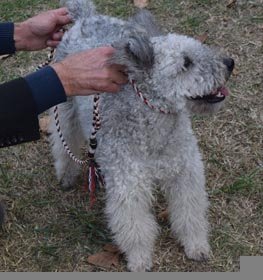 | |
| Origin | |
|
Common Names & Aliases
What other names is a Pumi known by? Discover all traditional, regional and informal names used for this breed. | Hungarian Herding TerrierHungarian Pumi |
|---|---|
|
Breed Classification
What type of dog breed is a Pumi? Learn about its genetic classification and breeding category. | Purebred |
Photo Gallery of the Pumi Breed
|
Size Classification
What size category is a Pumi? Learn how big the Pumi breed typically grows. | Medium |
|---|---|
|
Weight Statistics
How much does a Pumi weigh? Discover typical weight ranges for adult males and females of the Pumi breed. | Male: 22–33 pounds (10-15 kg), Female: 18–29 pounds (8-13 kg) |
|
Average Weight
What is the average weight of a Pumi? | Male: 22–33 pounds (12.5 kg), Female: 18–29 pounds (10.5 kg) |
|
Height
How tall is the Pumi? Pumi height: | Male: 16-19 inches (41-47 cm), Female : 14-17 inches (38-44 cm) |
|
Average Height
What is the average height of a Pumi? | Male: 17.5 inches (44 cm), Female : 15.5 inches (41 cm) |
|
Price Range
How much does a Pumi puppy cost? Find current market prices and factors affecting Pumi costs. | $500-$1200 If you choose to purchase the Pumi, you should know that the mentioned amount of money is an average of the collected data from breeders’ sites and puppy finder places. If you have a Pumi for sale, please advertise it on a reliable website to make sure the Pumi gets to a happy place. |
|---|---|
|
Availability
How easy is it to get a Pumi? How many Pumi are there in the world? | Frequent: The Pumi is easier than average to get. Maybe there is some risk of overbreeding, as it is a popular breed. Due to its popularity, inbreeding may occur. A new study shows that inbreeding contributes to the incidence of disease and health problems. So be careful and seek the help of an experienced person or a professional, in making your decision. |
|
Intelligence Rating
How intelligent is a Pumi? Discover the Pumi's intelligence ranking and learning capabilities. | Average: It takes patience to teach this breed any tricks or commands, but the effort is worth it. They understand and remember new commands after an average of 25-40 repetitions.
The Pumi ranks average in the intelligence ranking of dogs. |
|---|---|
|
Training Difficulty
How easy is it to train a Pumi? Learn about the Pumi's trainability and response to training methods. | Pumi dogs are easy to train. They find out the association between commands and actions quite quickly. |
|
Watchdog Rating
How good is a Pumi as a watchdog? Learn about the Pumi's alertness and guarding instincts. | Pumi dogs are one of the best watchdogs. Their main job is to observe and they're very consistent in their effort. The best vocal cords and sense of hearing belong to them. Usually, they're very territorial and protective about their property, so the Pumi dogs will alert you if they sense something different. |
|
Territorial Protection
Is a Pumi protective of its territory? Learn about the Pumi's guarding instincts and behavior. | Pumi dogs strongly protect their territory. This breed is a complete security guard, so you don't have to be afraid in case of danger. |
|
Personality Traits
What personality does a Pumi have? Learn about characteristic Pumi temperament and behavior traits. | ActiveProtectiveAlertSensitiveIntelligentLivelyRestlessReservedVocalExtremely BoldSuspicious Towards StrangersNoisy |
|---|---|
|
Sensitivity Level
How sensitive are they? Pumi sensitivity: | Pumi dogs are less sensitive than other dog breeds. They aren't receptive to their owner's emotions and handle soft punishment quite well.
They don't mind an always changing daily routine, a hectic household, young children, a noisy or office environment, and frequent guest visits. |
|
Affection Level
How affectionate are they? Is a Pumi a good family dog? | High: Pumi dogs are genuinely loyal, soft and gentle, loving, and affectionate dogs toward their handlers. They enjoy quality time with their owners despite the activity and are considered great therapy dogs for those in need. This breed responds strongly to their handler's emotions because they bond closely. Their happiness is your happiness. |
|
Social Needs
How much social interaction does the Hungarian Herding Terrier need? Pumi social needs: | Pumi dogs need a lot of social interaction. They desire to always be with someone or around people. This breed hates being left alone. |
|
Impulse to Wander or Roam
How likely is the Pumi to run away? Does this breed explore or wander a lot? Does Pumi roam? | Pumi dogs have high wanderlust potential, which means that this breed has a strong desire for exploring the world. Safer to walk them on a leash unless you teach them how to get back to you on command. This breed is also able to cause damage to your fence. |
|
Prey Drive
Do this canine have a strong prey drive? Does Pumi have high prey drive? | Pumi dogs have an average prey drive, which means that they don't have a high impulse to chase and catch something like a cat or any other small aminals, but it might happen. Training can help to achieve good behavior. |
|
Barking Frequency
Does a Pumi bark a lot? Learn about typical Pumi vocalization patterns and triggers. | A lot: Pumi is a particularly loud breed. They often enjoy barking and howling loudly. If you want a quiet dog, not the best choice.
The main triggers for barking are fear, attention, alarm, boredom, greeting, separation anxiety, compulsive barking, and defense. |
|---|---|
|
Playful Nature
How playful is a Pumi? Understand the typical play drive and energy level of the Pumi breed. | The Pumi is a highly playful breed. Excited barking and sometimes nipping will alert you to play. |
|
Apartment Adaptability
Can a Pumi live in an apartment? Learn about the Pumi's suitability for apartment living. | It is not the best choice if you want to keep them indoors, however, with careful exercise and several walks a day, they will tolerate the indoor environment, so it is possible to keep Pumi indoors. |
|
Lifestyle Adaptability
How adaptable is a Pumi to lifestyle changes? Learn about the Pumi's flexibility to new situations. | Pumi dogs adapt very well to lifestyle changes and basically all living environments. They don't mind moving from one place to another with their owner. |
|---|---|
|
Alone Time Tolerance
Can a Pumi be left alone? Learn about the Pumi's tolerance to solitude. | Pumi dogs tend to have separation anxiety when their owners left them alone at home because they bond very closely with them. |
|
Bite Risk Assessment
What is a Pumi biting potential? Learn about the Pumi's bite risk factors. | Low 🔽 The Pumi has a low chance of biting somebody. Top reasons for dog bite: protection, pain, excitement, herding instinct, being provoked. (Data based on the available online bite statistics.) |
|---|---|
|
Mouthing Tendency
Is a Pumi mouthy? Learn about the Pumi's tendency to use mouth during play. | Pumi dogs have a higher than average tendency to nip, chew, playbite, or herd people. It's a common habit during puppyhood, not aggressive behavior. These "bites" don't hurt, but Pumi dogs need to be taught a good attitude. |
|
Bite Strength Rating
How strong is a Pumi bite? Learn about the Pumi's bite force measured in PSI. | Between 200 and 400 PSI ⏺ Pumi bite force: Ordinary. Bite force Pumi measurements typically fall within the range of 200 to 400 PSI. The bite force of a Pumi is considered ordinary when compared to other dog breeds, but it is still quite powerful. This Pumi bite force PSI can cause bite wounds. Pumi bite PSI is not something that should be feared if the dog is well-trained and managed. To avoid any issues, it's essential to learn how to train a Pumi puppy not to bite from an early age.
The Pumi, and many others, have a fearsome presence because they have significant jaw strength, so it is important not to anger the dog and have it around strangers until it is fully trained. However, they are usually quite calm and good companions, they work well in families and are easy to care for. In conclusion, while the Pumi bite force is certainly an interesting aspect of the breed, it is important not to let it overshadow the many other reasons why these dogs are so loved and respected. With proper training and socialization, a Pumi can be a loyal and protective companion for your family. |
|
Average Lifespan
How long does a Pumi live? Learn about the typical lifespan of the Pumi breed. | 11-15 years The average lifespan of Pumi: 13 years |
|---|---|
|
Climate Tolerance
How well does a Pumi handle different weather? Learn about the Pumi's climate adaptability. | Tolerates warm and cold weather Dogs that tolerate hot and cold weather are typically those that have a double coat of fur. Dogs with a double coat of fur have a layer of fur that insulates their skin and helps protect them from the cold and the heat. |
|
Health Concerns
What health issues are common in a Pumi? Discover typical conditions affecting the Pumi breed. | Pumis tend to have more frequent health issues than other breeds. Regular vet check-ups are needed.
|
|
Vet Care Frequency
How often does a Pumi need vet visits? Learn about the Pumi's veterinary care requirements. | Frequent The Pumi should have a complete physical check-up at least once (but preferably twice) per year. If your dog shows any symptoms, call your veterinarian. |
|
Health Problems
What genetic/health problems does the Pumi breed have? What are the health issues and concerns of the Pumi breed? Most common health risks of Pumi: | Hip Dysplasia Patellar LuxationElbow DysplasiaDegenerative MyelopathyPrimary Lens Luxation |
|
Energy Rating
How energetic is a Pumi? Understand daily activity needs of the Pumi breed. | Pumi dogs are high-energy dogs. An active lifestyle makes them happy. |
|---|---|
|
Activity Requirement / Exercise Need
How much exercise does a Pumi need? How much exercise do Pumi dogs require per day?
Do Pumi dogs need a lot of exercises? | Pumi dogs need quite a lot of exercise. Daily walks should be on schedule. If you live an active life, this breed can be a good choice for you. |
|
Sleeping Need
How much sleep does the Pumi breed need? | Pumi dogs don't need too much sleep. They are energetic and desire to live active life. If you think naps are overrated, this breed can be the best choice for you. |
|
Obesity Tendency
Is a Pumi prone to weight gain? Learn about the Pumi's obesity risks. | Average: The Pumi has an average risk for obesity. Daily walks should be on schedule. To make your dog happy and fit, feed him with quality dry dog food and live an active life together. Try to find the happy medium between exercise and feeding.
If you notice any weight gain, consult your veterinarian and make a diet plan. Reduce unhealthy food and snacks, and measure the Pumi weight regularly. |
|---|---|
|
Food Consumption
How much food does a Pumi need daily? Learn about the Pumi's feeding requirements. | 1 to 1.5 cups of high-quality dry food a day, divided into two meals. |
|
Allergy Friendliness
Is a Pumi hypoallergenic? Learn about the Pumi's suitability for allergy sufferers. | Yes Pumi dogs do well with allergy sufferers by causing fewer allergic reaction. However there are no 100% hypoallergenic dogs in the world, there are a variety of breeds that are considered to reduce or minimize the possibility of an allergic response. Coat type isn't necessarily relevant, because most people are allergic to dander (flakes on the dog's skin) or saliva, not actually to dog hair. |
|---|---|
|
Coat Colors
What colors does a Pumi come in? Discover all possible Pumi color variations. | Black White Grey in various shades (normally, the colour at birth is black, turning grey with time)Fawn. Primary colours: red, yellow, cream (a trace of black or grey and a distinct mask are desirable).A white mark on the chest less than 3 cm in diameter and/or a white line on the toes are not faulty. The coat colour must always be intense and solid. |
|
Grooming Requirements
How much grooming does a Pumi need? Learn about Pumi coat maintenance requirements. | Average: The Pumi requires average grooming effort. Cutting the dog's hair by a professional groomer isn't essential. Brushing the dog's coat is useful to reduce shedding. Ears and eyes should be cleaned regularly to avoid infections. Don't skip the seasonal flea treatment too. Dog nail trimming and dog bath can be helpful sometimes. Check the local pet store for dog grooming supplies and find the best dog shampoo to keep its coat healthy and give your dog a pleasant experience of a dog bath. If you don't have the time, skill, or money to take care of your Pumi, search for a dog groomer or clipping service in your area and book an appointment. Maybe you're lucky to have a dog boarding service that includes grooming or walk-in dog bath places nearby. |
|
Drooling Tendency
Does a Pumi drool a lot? Learn about the Pumi's drooling habits. | The Pumi is an average drooler. Drooling is the unintentional saliva flowing outside of the mouth. It can be completely normal or a sign of a health problem.
If you notice any change in your dog's drooling habit, you should contact a vet as soon as possible. |
|
Stinkiness Rating
Does a Pumi smell bad? Learn about the Pumi's natural odor levels. | Medium ⏺ The Pumi has an average chance of bad smell. Top reasons for dog stinkiness: infection of bad tooth/ear/skin folds, gas attacks. |
|
Coat Characteristics
What type of coat does a Pumi have? Learn about the Pumi's fur characteristics. | WiryDenseCurlyWavy |
|
Bathing Needs
How often does a Pumi need baths? Learn about the Pumi's bathing requirements. | 3-4 weeks More often than average. These dog coats tend to be longer, softer, and oilier than short-haired breeds. While a good bath every now and then is a great way to keep your buddy from becoming overly smelly, be mindful about overbathing.
Bathing will wash away your dog’s natural oils, while a simple brushing every few days should keep them clean. |
|
Shedding Level
How much do Pumi dogs shed? How to control, reduce and prevent the shedding of the Hungarian Herding Terrier? Do Pumi dogs shed a lot? | Pumi dogs shed moderately. It's a natural process of the hair growth cycle. Regular brushing reduces the amount of hair that sheds. It mostly depends on their health status and breed type. |
|
Child Compatibility
Is a Pumi good with children? Learn about the Pumi's behavior around kids of different ages. | Pumi dogs are kid-friendly dogs. This breed is a good choice if you have children. |
|---|---|
|
Pet Compatibility
How well does a Pumi get along with other pets? Discover the Pumi's compatibility with other animals. | Pumi dogs are generally with other pets. |
|
Stranger Friendly
Are they aggressive or friendly towards/with strangers? Pumi temperament with other people: | Pumi dogs are not the most stranger-friendly dogs. |
|
Cat Friendly
How well do Pumi dogs get along with cats? Are they good with kittens? What is this fido's temperament with cats? Can they be good with cats? Can the Pumi breed live with a cat? | Pumi dogs are average friendly towards cats. |
|
Dog Friendly
Is Pumi good with other dogs? Are they dog-friendly dogs? How well do Pumi dogs get along with other dogs? | Pumi dogs are average friendly towards other dogs. |
|
Good For First Time Owners
Is Pumi breed good for first-time owners? Do they make a good dog for novice owners? Is Pumi breed suitable for first-time owners? | Yes Pumi dogs are good for novice owners, due to their easy-going personality. |
|
Office Friendly
Are Pumi dogs good office canines? Do Pumi dogs make good office-friendly pets? Can they be office dogs? | No Pumi is not the best dog breed for office environment. |
|
Senior Citizens Friendly
Are they senior citizens friendly dogs? How well do Pumi dogs get along with the elderly people? What is the Hungarian Herding Terrier temperament with senior people? Are Pumi dogs good for elderly owners? | Pumis are usually recommended for elderly people. |
|
Service Dog Capability
Can a Pumi be a service dog? Learn about the Pumi's service work potential. | Not really This breed generally not used as a service dog. A service dog is a term used in the USA to refer to any type of assistance dog specifically trained to help people who have disabilities, such as visual impairment, hearing impairments, mental disorders, seizures, mobility impairment, and diabetes. Service dogs are protected under the ADA (Americans with Disabilities Act).
Pumi is not the best breed for service purposes. |
|---|---|
|
Therapy Work Suitability
Is a Pumi good as a therapy dog? Learn about the Pumi's therapy work aptitude. | Not really This breed is generally not used as a therapy dog. A therapy dog is a dog that might be trained to provide affection, comfort, and love to people in hospitals, retirement homes, nursing homes, schools, hospices, disaster areas, and people with anxiety disorders or autism.
Pumi is not the best breed for therapeutic purposes. |
|
Scent Detection Ability
Is a Pumi good at detection work? Learn about the Pumi's scenting abilities. | Not really They are not typically employed for this type of work, but there may be exceptional cases. A detection dog or sniffer dog is a dog that is trained to use its senses (mostly its smell) to detect substances such as explosives, illegal drugs, wildlife scat, currency, blood, and contraband electronics such as illicit mobile phones.
Pumi is not the best breed for detection purposes. |
|
Search & Rescue Potential
Can a Pumi do search and rescue? Learn about the Pumi's SAR capabilities. | Not really This dog breed is not typically used as a search and rescue dog. The use of dogs in search and rescue (SAR) is a valuable component in wilderness tracking, natural disasters, mass casualty events, and locating missing people.
The Pumi is not the best breed for SAR purposes. |
|
Maritime Work Ability
Is a Pumi good on boats? Learn about the Pumi's maritime capabilities. | Not really Pumi breed usually doesn't like being on a boat. Boat dogs were typically bred for their strength, stamina, and water resistance, as they were often required to perform tasks such as pulling in fishing nets, and jumping into the water to retrieve ropes or lines, or helping to move cargo. Sailor dog is a type of dog that was bred to accompany sailors on their voyages. They were typically used for three purposes: as a working dog, a watchdog, and as a companion. A boat dog is a term used to describe a type of dog that was traditionally bred and used as a working dog on boats. |
|
Draft Work Capability
Can a Pumi pull carts? Learn about the Pumi's drafting abilities. | Not really A drafting dog or draft dog is a dog bred and used for cart pulling. Dogs bred for this work have strong builds and qualities that are needed, strength and determination.
Pumi is not the best breed for drafting purposes. |
|
Military Service Background
Was a Pumi used in military service? Learn about the Pumi's military history. | Not really In history, this breed was not really used for combat dog. |
|
Puppy Litter Size
How many puppies does a Pumi usually have? Learn about typical litter sizes. | 4-6 puppies |
|---|---|
|
Pregnancy Duration
How long is a Pumi pregnant? Learn about the Pumi's gestation period. | 60-64 days Reproductive cycle of the female Pumi: The first period called Proestrus lasts for about 9 days.
During this time the females start to attract males. You can notice by swelling vulva and bloody discharge. The second part is the Estrus when the female is receptive for the male. It lasts for about 3 to 11 days. The sign of the proestrus part is the soft and enlarged vulva. The discharge decreases and lightens in color. The third part is the Diestrus. Normally, it occurs around day 14. In this period the female’s discharge changes for vivid red and coming to its end. The vulva returns to average, and she will no longer permit mating. The fourth part called the Anestrus. The time frame between heat periods normally lasts about six months. |
|
Breeding Frequency
How often can a Pumi have puppies? Learn about safe breeding intervals. | Once a year. More frequent breeding is not healthy. It is very important not to buy a dog from a puppy mill, where the needs of the pups and their mothers are ignored. It's an inhumane high-volume dog breeding facility, where puppies born several times a year. |
|
AKC Classification
What AKC group is a Pumi in? Learn about the Pumi's AKC classification. | Recognized by the American Kennel Club in 2016 as a Herding breed. |
|---|---|
|
FCI Classification
What FCI group is a Pumi in? Learn about the Pumi's international classification. | Recognized by FCI in the Sheepdogs and Cattledogs (except Swiss Cattledogs) group, in the Sheepdogs section. |
|
Kennel Club Recognition
Which kennel clubs recognize a Pumi? Learn about the Pumi's official recognition. | American Canine RegistryAmerica's Pet RegistryDog Registry of America Inc.Federation Cynologique InternationaleNorth American Purebred Registry, Inc.American Canine Association, Inc.Continental Kennel ClubNational Kennel ClubFoundation Stock Service |
Pumi Pros and Cons
- Training Difficulty: Pumi dogs are easy to train.
- Allergy Friendliness: Pumi dogs do well with allergy sufferers by causing fewer allergic reaction.
- Watchdog Rating: Pumi dogs are one of the best watchdogs.
- Lifestyle Adaptability: Pumi dogs adapt very well to lifestyle changes and basically all living environments.
- Child Compatibility: Pumi dogs are kid-friendly dogs.
- Senior Citizens Friendly: Pumis are usually recommended for elderly people.
- Good For First Time Owners: Pumi dogs are good for novice owners, due to their easy-going personality.
- Health Concerns: Pumis tend to have more frequent health issues than other breeds.
- Mouthing Tendency: Pumi dogs have a higher than average tendency to nip, chew, playbite, or herd people.
- Impulse to Wander or Roam: Pumi dogs have high wanderlust potential, which means that this breed has a strong desire for exploring the world.
- Alone Time Tolerance: Pumi dogs tend to have separation anxiety when their owners left them alone at home because they bond very closely with them.
- Office Friendly: Pumi is not the best dog breed for office environment.
Pumi History
Pumi is a sheepdog from the herding breed closely related to the long-haired, but more well-known Puli, both originating from the Central-European country, Hungary. Pumis were bred to guard and to shepherd the cattle and the sheep. The development of the breed is probably can be traced back to the Tsang Apso (the Tibetan Terrier). The breed is an ancient one, regarding the fact that it was introduced during the migration of the Hungarian people from Central Asia more than 1100 years ago. The ancestral Hungarian sheepdog appears to have been brought to the west during the migration from the Ural-Altay regions around 800 AD.
Others suggest that the Pumi is a result of a later crossbreeding of French and German sheepdogs, such as the Briard, Pomeranians, the Spitz, and several other varieties of terriers during the 17th and the 18th century. The breed evolved spontaneously and was not the result of a well-planned breeding process. In the 18th century, a lot of Merino sheep were imported to Hungary, with small Pyrenean Mountain Dogs that was also a major contribution to the development of the Pumi with their signature short and curly coats.
The first drawing representing a Pumi is from 1815, from Hungary, where the dog was portrayed while working on the fields with sheep. The founder of the Hungarian Academy of Science (MTA), Count István Széchenyi was the first to initiate the breeding of pedigree dogs in Hungary. During the late 19th century, within the Austro-Hungarian empire, breeding of native Hungarian dogs was discouraged. In spite of that, in the early 20th century, more precisely in 1902, the first distinction between the Puli and the Pumi was published because Hungarians started to separate their herding dogs into various breeds. In the 1910s controlled and well-planned breeding began, yet many large herds and their dogs were lost during the First World War, and later the subsequent division of Hungary. Later the geographic separation of Hungarian breeds became clearer within borders, the Puli was common on the east Hungarian plains, the Pumi in the hills of West Hungary.
In 1921, a breed standard was created for the Pumi by Dr. Emil Raitsits, who referred to the Pumi as a “sheepdog terrier”. The breed's population rose between the two world wars, with 130 dogs registered in 1924. Also, around that time, the breed entered into both national and international dog shows as working dogs. Being a fancier of the breed, Dr. Raitsits was determined to preserve the breed’s typical terrier qualities and behaviors. In 1927 the breed Puli and Pumi were officially separated and the Pumi standard drawn by Dr. Raitsits was approved by the FCI in 1935. The FCI also gave the Pumi its official scientific name in Latin after Dr. Raitsits.
After the Second World War breeding became possible again. The Pumi was first introduced to the Scandinavian region in 1972 when the breed was exported to Finland, where even to this day the Pumi is one of the most popular herding dogs. They also conquered Sweden, the Netherlands, Italy, and in the early 1990s even the United States.
The Hungarian government named the Pumi as one of its eight indigenous dog breeds in 2016 and also created a gene bank to preserve the breed’s true and unique characteristics.
Latest Pumi Compares
Pumi Names
How old is my Pumi in human years?
You May Also Like
Rate The Pumi Breed
Pumi Comments, Reviews and Questions
- Pumi Owner
Jan 8, 2023, 9:58:01 PM:
I'm a first time dog owner and I love my pumi. He is a bit reactive towards other dogs tho since he's so curious and playful. So social training as a puppy is very important.
- Poppy or another Pumi owner
Mar 10, 2022, 6:53:22 AM:
Pumi's are great dogs but really they are not for first time owners they are also very stubborn
- Pumi Owner
Jan 26, 2021, 12:10:31 AM:
Who wrote this article? Do you actually own a Pumi? No one in their right mind who owns a Pumi would call it "easy going." Or "good for first time owners." This is a high-drive sheep herding dog that needs regular (and constant) exercise.


